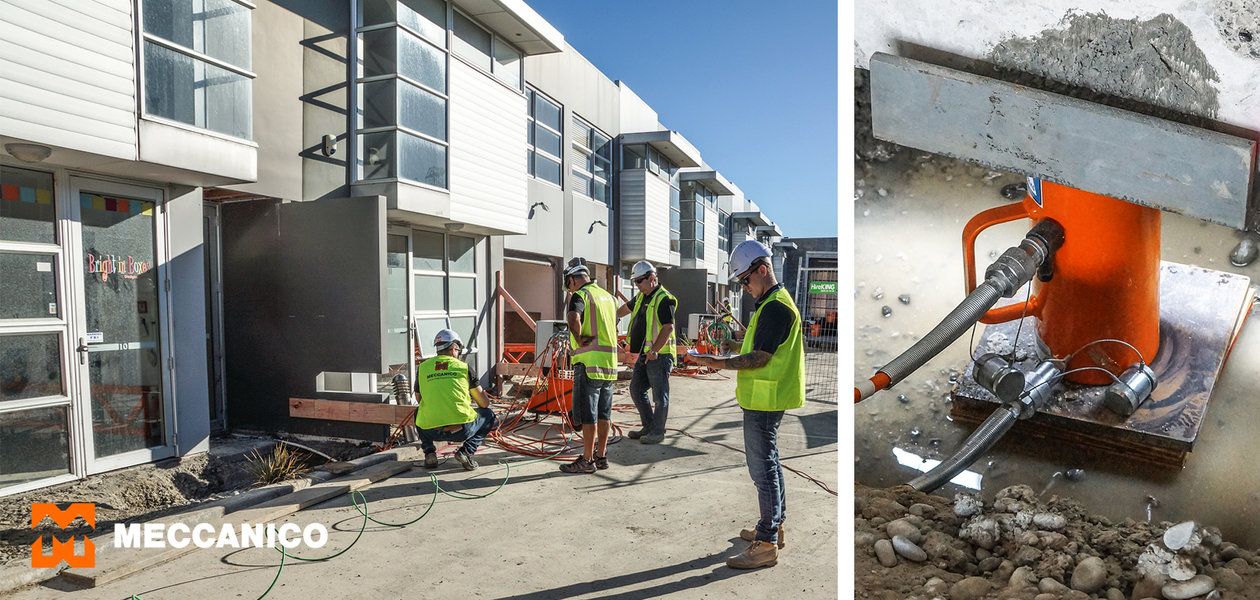提升、降低和调平建筑物

提升、降低和调平地震受损房屋。 经House Lifters委托,荷马特提供了一个2,000吨同步定位系统。
委托机构:House Lifters/Meccanico
所在地:新西兰
所在地情况
House Lifters在基督城和坎特伯雷提升并重新调平数百个地震受损房屋,包括商业区、住宅、遗产建筑和教堂。
挑战
为了确保安全可控地提升、降低和调平大型房产,House Lifters正在寻找灵活、易于操作和极为精确的同步提升系统。 因为复杂的提升过程也经常需要“倾斜”,所以,这是新系统“必备的”特征。
解决方案
荷马特开发了一个2000吨同步定位系统,可选择确定重心(COG),还能够在必要时称重负载。 该系统配有6个双作用泵单元,每个单元具有4个单独的用于所有24个提升点的油流。 由于系统的模块化设置,泵单元可以放置在物体周围,然后连接在一起。 由于这种设置,从泵到提升点的距离可以保持相等并且限制在最小值。 这导致提升和降低更加稳定,大大降低了振动。 该模块化设置也提供巨大的灵活性;该系统易于控制和移动(不需要任何额外的设备,例如起重机或叉车): 主要优点是工作现场不易进入,起重机无法进入工作现场。
这些泵通过连接到具有触摸屏的便携式HMI(人机界面)的数据电缆连接在一起。 系统上的软件允许用户设置执行复杂升程所需的确切参数。 如有某物超过给定参数(例如重量的意外变化),则系统自动停止升降机,使得用户可以在重新开始升降机之前安全地检查和固定物体由于双作用气缸,用户在提升和降低动作上都具有最大限度的控制,因为不依赖重力来降低负载。
荷马特同步定位系统可以通过增加更多的泵和气缸轻松地升级,在提升、降低、调平和称重方面几乎是无限容量。
Rod Moore, owner House Lifters and Meccanico: "Six years after the Canterbury earthquakes we noticed our work was ramping up for straightening commercial buildings instead of mainly private properties (houses). When I was doing research for a heavier system I discovered most jacking systems available were big and required trucks to bring in all the gear. The Holmatro system on the other hand seemed to be small and I only needed a few guys to do the job, so I decided to invest in a synchronous computer-controlled hydraulic jacking system from the Dutch company. The system was built entirely on my requirements and delivered by two engineers who came out to New Zealand to train my employees and help us get things going. With great success. We lifted the concrete floor of a 340 ton building at Ferrymead (Christchurch) 200 millimeters to re-level. After placing 25 jacks, we connect the hydraulic pumps and the wires to the computer to measure the heights. With other systems you need several guys to go around all the jacking points and try to raise them simultaneously. This system monitors all the points at once as the building is slowly lifted. In case of a problem like a jacking support being squashed, it alerts and stops so nothing breaks. Once the building was raised to level, sacrificial props were placed underneath with the assistance of sledgehammers and the voids underneath were filled. The final job was to run a radar test to detect any gaps. The center of the floors were also monitored for sagging and a beam and screw system could lift areas that needed it. Imperfections in the original concrete floor showed up, but we got it back within 0.1mm to the original pour of the slab.”
您想了解更多关于此项目的信息吗? 请通过电子邮件 [email protected] 或致电 +31 (0)162 751500. 联系我们。